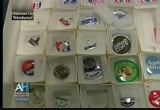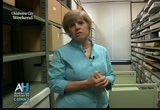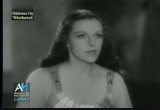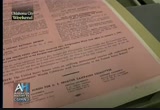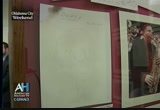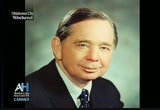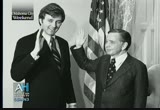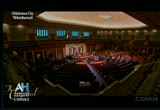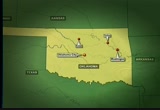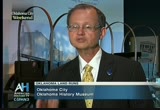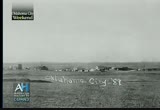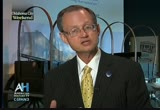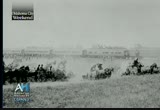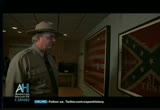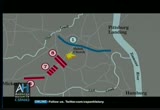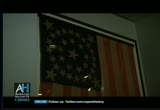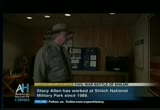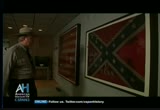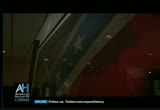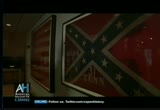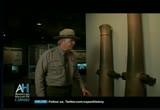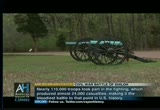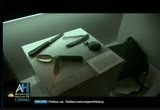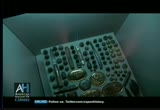tv [untitled] May 5, 2012 7:00pm-7:30pm EDT
7:00 pm
economy. >> how did these pins come to your collection? >> well, when we get a collection, sometimes it's somewhat organized and sometimes it's not terribly organized, but the members will have as part of their collection some of these, this memorabilia, plaques, other sorts of things, and then sometimes we just have people who over the years know that we are in the business of preserving political history, and they will offer to make donations to us. we generally do not purchase items for the collection. they are donated to the collection. some of these would have come from different collections, but they're preserved here in one. you know, one of the things that this -- the senate historian's office emphasizes to members is that you want to put your collection someplace where it has the capacity not only to preserve and keep your collection but also to process it and make it available to
7:01 pm
scholars, and that's why we think we urge many of our members here in the state of oklahoma to make their donations to us. one of our most interesting collections and one that it gets used quite a bit is helen kahayden, douglas who served in the 1940s and was from california. what is interesting about helen kahayden douglas is that she was married to the hollywood actor melvin douglas. served during the 1940s, from california. and had a very distinguished acting career, and so we have -- actually have some of her stage photos. very imposing presence here. this is a promo photo from the one film that she made which was called "she." and the name of the character that she played in this was she,
7:02 pm
who must be obeyed. >> there will be slaves waiting at the outer wall to guide you in safety into the world. >> it is a, probably more of a cult film now than it is a well-known film, and it has something to do with, you know, the fountain of youth and eternal light. >> how did she get involved in politics? >> well, she and her husband moved from new york, and the east coast, to hollywood, and she got involved in the plight of migrant workers in california, and her activism there also, then, drew the attention of eleanor roosevelt. she became a democratic committee woman and then ran for congress in the wartime era of world war ii. she went on, then, to try to aspire from her congressional career to run for the u.s.
7:03 pm
senate. she ran for the u.s. senate in 1950, and she ran against another congressman from the state of california, richard m. nixon. and this was a very nasty campaign. you may remember that this is also the time of the, the beginning of the rise of the red scare, and so one of the things that nixon accused helen douglas of was a voting record that was leaned towards the extreme left in the communist party and this is called the pink sheet. this was issued by the nixon campaign committee. accusing her of many votes against the committee on un-american activities, and votes against the loyalty and security legislation. votes against california. and tying her voting record to a
7:04 pm
congressman in new york, and casting both of them, really, as communists. you'll note down here in the corner, the lipstick, which we believe is from helen douglas, was her response to the pink sheet that was being put out by the opposition. she was unsuccessful. richard nixon did win that campaign, and she did not run for another elected office after that. so her primary tenure was in the u.s. congress. the center has wall exhibit space where we have rotating exhibits. this particular one happens to be about david elborn who served as governor and u.s. senator and now is the president of the university of oklahoma. one notice of significance, we also have the papers of his father, lyle, and just recently,
7:05 pm
retiring congressman dan born has signed a deed to commit his papers here. so we'll have three generations of the born family in terms of paper. you can kind of see the range of things that are in our collection from official correspondence and clearly political papers to those things that are more personal and non-political from -- everything from notes and cards. over here we have another exhibit of materials that come from young constituents, children, who would write to the their congressman and send them handwritten letters. so you have both insight into the personal lives of these members as well as the official activities that they were involved in. the most significant part of the center's physical setting is a replica of the speaker's office, and this is the speaker's office
7:06 pm
for carl albert who was the 46th speaker of the u.s. house of representatives, and the space itself actually had furniture and pictures and memorabilia from his capitol office right off the house of representatives, as well as his office in the canon office building. his direct, his office for his district in oklahoma. and we've tried to maintain h e here, you know, many of the important memorabilia from his collection, and i'm just pointing out a couple of things that are particularly significant. this display cabinet has 50 pins in it, which reflect the great society programs that mr. albert played a key role as both majority leader and then whip working with president johnson to enact what we have come to know as the great society
7:07 pm
initiatives. it really is symbolic of the legislative agenda. there's one other case like this, and that's at the lbj presidential library at the university of texas. he was from very humble roots, a little town calmed bugtussle down in oung eastern oklahoma, but this is a little league team from elmore city, also a little town in that neck of the woods, and he, mcallister was considered his home and when he left the congress, he retired to mcallister. he didn't stay in washington. he didn't go on to lobby or do something, you know, to make more money. he really saw himself returning to his roots, and so that's what he did. one other little thing. he was not a tall man, which is why he's known as the little
7:08 pm
giant from little dixie, which is the name we give to southeastern oklahoma. he was 5'4", and if you look under the desk here you can see, he has a little stool. that's his original stool to lift his feet up so that he could elevate his chair and be a little bit more of an imposing feature behind the desk, but he certainly lived up to his nickname of the little giant from little dixie. >> why collect all of these items? the papers, the physical items? why is that important? >> well, certainly, you know, we think of this center as a living tribute to the importance of representative democracy, and if you don't honor that history, if you don't preserve that history, we are poorer for it in terms of
7:09 pm
understanding this important institution in our government. certainly right now congress is not held in high esteem by many people, but the health of our representative institutions is -- is something that we need to care about as a society, and so part of what we do here at the carl albert center in terms of the civil engagement activities that we undertake is to remind people that we cannot neglect these important institutions. all weekend long, american history tv joins our cox communications cable patter int partners in oklahoma city. showcasing literary culture. oklahoma city is the largest city in oklahoma. it has a population of about
7:10 pm
600,000 people, and is the sooner state's capital. you're watching "american history tv" on c-span3. at high noon, the guns fired and the cannons go off and the flags go down and 50,000 people rush for free land. the land run was a unique way of opening the public lands. since the 1860s, congress had a policy on the books called the homestead act, and the homestead act said that anyone who would move to the frontier on to public domain and would stay for five years and make improvements and satisfy all of those conditions, they would receive title to the land. because basically free land to encourage settlement. the west was searchly sett lset through kansas into new mexico, through arkansas, and so all of the land around us is settled in the 1860s, 1870s and into the 1880s. well all of this time, oklahoma is withheld from settlement at
7:11 pm
the ind yant territoian territo. the president started moving tribes out of the southeast, the midwest, out of the atlantic coast states and moving them to oklahoma until we had 39 tribes here. so from the 18-teens, one vast indian reservation as others are abolished and those lands opened. this one last island of aridable land that can be farmed and everyone wants it. where in 1889, there are no more tribes to bring into the territory. but yet there's one parcel right in the middle of the indian territory that's unassigned, and so it gets its name, the unassigned lands. today it goes from roughly stow water on the north to norman, oklahoma on the south. where located today, shani on the east to el reno on the west. it's about six counties of
7:12 pm
oklahoma. not owned or settled by any other indian tribe. congress decides to open this and let people claim the land. how do you do it? it's a small partial of land. a lot of people wanting the land. so if you take the political philosophy of the time, laissez-faire government, government he's in to step back into the-keep your lands off daily life. let the free enterprise system work. secondly a social philosophy. darwinism and evolution, survival of the fittest. the theory that the fastest and the smartest will survive. the dumbest and slowest won't. so let's open it up by land run, keep the government out of it, and let people run for it. the first to get to 160 acres of rural land, or a town lot in one of the towns, claims it, defends it, stays on it for five years, gets it for free. so congress sets a date for the land -- the very first land run.
7:13 pm
april 22, 1889 high noon. on that day 50,000 people line up around the borders of the territory and at high noon the cannons go off, the guns fire, the flags go down, a variety of means, 50,000 people rush for free land. about half go to 160-acre farms. the other half go to towns, such as stillwater in norman. in guthrie, which would be the territorial capital. oklahoma city, this little town in the bend of the north canadian river nap night every part and parcel of the unassigned lands is claimed by somebody. these were towns born grown in one day. oklahoma city had 10,000 people that night. that morning, only a handful. guthrie, 10,000 people. and so the land run was this experiment and a way to settle the american west. was there cheating? yes. were there people who name early? yes. were the united states deputy
7:14 pm
marshal whose took advantage of the opportunity? yes. court cases, yes, they would drag on almost a decade. the laissez-faire did not work well. yes, fastest riders, the cowboys had trained mustangs, knew the territory because they'd been driving cattle across the land. the farmers who may have been the pillars of their community, if they were in a wagon, has h a family, maybe they not get land. so both of those philosophies of government and social evolution were only partially true, but nevertheless, that day part of the american west was settled. well, after 1889, other parts of the indian territory were taken away from indian tribes and put into the public domain. they call it the allotment process. so the federal government would negotiate with the fox and the
7:15 pm
potawatamy. others picked off. biggest of the land run, cherokee in northern oklahoma just on the kansas border was opened by land run. 100,000 people made that run. 1901, the last of the real big ones. the old comanche lands in the southwestern part of the state all opened and won by lottery. they realized land runs weren't working. let everyone put their name on a sheet of people into a hopper, full out. the fifth homestead goes to -- john smith, and sthey celebrate and get their land. with the five civilized tribes, there are so many members of the tribes generally the land is dwighted. >> divide equally. the process is completed by 1906 and in 1907 oklahoma become as state. this is a land of contrast, diversity and for a his tore yarngs i've been studying
7:16 pm
oklahoma history 32 years, 18 books. i never cease to be amazed at the pieces of this puzzle that fit together in odd and unique ways that make oklahoma unlike any other state in the union. stay tuned all weekend long as american history tv features oklahoma city, oklahoma. learn more about oklahoma city and c-span's local consent vehicles at c-span.org/localcontent. next month we'll feature wichita, kansas. you're watching american history tv all weekend every weekend on c-spa c-span3. the civil war battle of shiloh took place april 6th 7th 1862 in hardin county tennessee and resulted in a victory over confederate forces. visited shiloh military park where stacy allen, the park's
7:17 pm
chief ranger talked about artifacts on display including arms and munitions and personal effects from soldiers who fought in the battle. he also took us behind the scenes to the park's storage facility where he showed us two rare civil war hats. >> here at the visitor center, refer to it as the shiloh battlefield. a collection of items on display and exhibit for the public to give them a taste and feel of the period. our museum collection here inside the center is object oriented. we have battle flags that saw service here at shiloh. what's unique about this flag is that it carries the pittsburgh landing battle honor that was the official name recorded by union forces for the battle at shiloh. united states forces had a tendency to name their battles after geographic land points,
7:18 pm
and in this kashcase, landing b the primary feature here. officially the battle went in as battle of pittsburg landing. newspaper accounts talk about the battle of pittsburg landing. referring to it at the battle of shiloh. the name biblical in connotation meaning "place of peace" or "house of peace" took predominance over the identity of the conflict through time and so it's interesting to see a battle honor for a pittsburg landing on these flags. this was in the possession of lucius d. woodruff of the 21st missouri infantry. a unit that participated in the battle with prentice' division that fought at the hornist the nest. flags underwent rhone vaenovati dark fabric, the lighter fabric
7:19 pm
filling out what's missing on the flag. same is true for the white stripes as well. you can see that the flag was in tatters. these fabrics, of course, ravages of time, storage, light. moisture. you name it. it's amazing that things like this do survive, even if they're stored away in an attic somewhere. usually they go through some major deterioration over time, if they don't have proper treatment and care. people are always fascinated by the unique star configurations on the flags. because there's no standardization to them. many of them were sewn by ladies in the communities in which these organizations were raised and thus the flag would be presented to them, to the units, as they marched off to war. an honor to be carried and cherished, and so a little bit of the artist's freedom to alter
7:20 pm
configuration of the star patterns in particular. this other large u.s. flag is a battle relic. apparently captured by the 16th louisiana infantry, major daniel goberg had this flag in his possession. the confederate's report, officially they saw one flag against the many u.s. flags that they captured at shiloh, and this flag would appear to be large enough to have been a garrison flag. personally, i and other staff members believe that this flag probably flew over john a. mcdowell the brigade tent, probably his headquarter, part of sherman's division and the right flank of sherman's division as it lay encamped around shiloh church. there's another union camp that
7:21 pm
they occupied that night for the north. one of the brigades of mcclerned's division. it's a probability as well. the highest probability, the 16th entered mcdowell's camp there for some time and i could see them taking this flag and this was donated to the park years ago from descendants of major goberg. it's in good shape. showing that it was well cared for and stored. even though apparently this had been buried at one time in the ground. that's the story. that's the family story, with a loved one for a while. in a grave. i'm not sure, but it was recovered later, and that's how they claim that the staining occurred. it may have gotten wet underground at that point in time. all of the flags underwent major conservation treatment so they can be properly exhibited. the next flag is not a relic of
7:22 pm
the battle, having a -- or been a witness flag in the battle. this is an 1864 dalton patterned confederate flag adopted by the army of tennessee at that point in time and issued to the troops. it was in bad shape when it arrived here in a brown paper bag. the gentleman walked in, threw it down on the visitor center information desk. which just happened to be manned by the chief ranger at that time, george reeves. threw it down and said this thing's causing so much trouble in my family i'd just assume be rid of it. it's yours if you want it. he said he just about fell over in his chair to get the information when he realized what he had inside the paper bag. the flag was in tatters. new material has backed the historic materials so there's a differentiation of it and it completes the flag, and can you see, come up and examine it real close that much of the -- of the
7:23 pm
flag was missing when it arrived here. it also probably contained in these missing quadrants other -- that the 51st tennessee would have participated in. the one that seems to have arrived is the shiloh honor. early in the history of shiloh, in the -- say, the first 50 years or so, historiography of the battle, there's been some question whether the 51st actually participated. they were at donaldson. some captured. seemed to have formed and junctioned up with the 52nd tennessee. not formally with them until after the battle of shiloh, but they wouldn't have been able to put a battle honor on the flag without being present. we do know the flag has been rearranged some since probably it's initial issue. that may have been post-war. it's hard to tell, but the placement of the regimental
7:24 pm
identity and things is a little bit different than what is standard with these dalton flags. clearly a civil war witness flag, and, again, one that has survived the test of time. to come to shiloh and interpret the -- the colorful part in the civil war, which was these battle flags carried by these organizations which were identity flags. in other words, you could look out and identify the united states over the battlefields, not only friend and foe but identify the respective organizations. cannons are brought in basically because they each have some convenience, a story to tell. early in the war, it's difficult to pinpoint specific guns on these battlefields. records were haphazardly kept earlier in the war. later in the war it's easier to take a particular gun and be able to link it to specific
7:25 pm
actions, campaigns and engagements. but we do have a piece here that is a shiloh veteran, did see service here. captured by the confederates here from the u.s. forces. retaken by those same u.s. forces on day two, and then at the battle of richmond, kentucky, confederates took this a second time. so it has a story past of a gun trading hands more than once between opposing forces. we are quite lucky that we have a very diverse collection of field artillery. on the battlefield. a lot of different types of guns at shiloh that you don't see elsewhere. every gun apparently on the battlefield, all the field artillery on the battlefield and the two siege gun was either made prior to or during the american civil war. so these are actual historical pieces from that time. they were united states arsenals
7:26 pm
when the national military park was established, and the commission then requisitioned 25010 for the marking of the battlefield and use in monuments as well. we're lucky. lucky it's one of the first battlefields sites to be set i side and that these artillery piece was still housed in the united states arsenal and available for marking the battlefield. a lot of people don't realize in the emergency of world war ii, in the need for a national effort to wage a global war, secretary of war, one of the cannons off the battlefield crossed the country for a drive and luckily the secretary the interior was made of stern stuff. had a few words for the secretary of the war and managed to hold on to the cannon and promised that the national park service would provide the scrap that would be demanded of the agency for the drive. so when the exhibits were planned and being designed, the
7:27 pm
staff at that time in the park service, the park service people, decided that these guns which at one time were on the battlefield would be used to be a part of the exhibit. a lot of the items in the exhibit are donated items. they're general in nature in the sense that they don't have any convenience directly to shiloh, but they represent, of course, the kind of quipage kind of weapons utilized in war as well as personal items that may have been possessed by individuals. now, much of the personal items that you have on display are accounting to shiloh, because a great deal of it were recovered with the excuse meation of the national troop beginning 1866 through 1866 and remained at the national cemetery, transferred over to the national parks service when the cemetery became part of the administration, park
7:28 pm
administration. so these items do have some convenience to shiloh. particularly the personal possession items, whereas the larger things such as belts and others are items donated to the park but night not have park convenience but do have civil war convenience. you see the silver dollar. that's kind of an item that cropped up at, again, based upon oral history tradition. apparently the general paid for bread between columbia and savannah and these people still possessed the gold dollar, and it's amazing. that that story staiyed. it's wholly believable. there's nothing to disprove it, but it fits. buying fresh bread for the general's commissary. and these are all artifacts off
7:29 pm
the field. again, a number of the items are items recovered with the national dead. you see ovm belt plate. ohio volunteer militia. you see jackknives. almost everybody had a knife of some type. some had big bowie knives like many of the confederates. the buttons are off the field. collected off the field. some would have come up with the war dead. this exhibit always attracts attention. people just sit there and look at all that stuff throughout. the round. but indeed a witness to shiloh would be this grimsley saddle, belts and sword carried by major john mcferrin, who was in the 70th ohio infantry serving in sherman's division. assigned to ralph's brigade. would have been on his horse as
139 Views
IN COLLECTIONS
CSPAN3 Television Archive
Television Archive  Television Archive News Search Service
Television Archive News Search Service 
Uploaded by TV Archive on

 Live Music Archive
Live Music Archive Librivox Free Audio
Librivox Free Audio Metropolitan Museum
Metropolitan Museum Cleveland Museum of Art
Cleveland Museum of Art Internet Arcade
Internet Arcade Console Living Room
Console Living Room Books to Borrow
Books to Borrow Open Library
Open Library TV News
TV News Understanding 9/11
Understanding 9/11